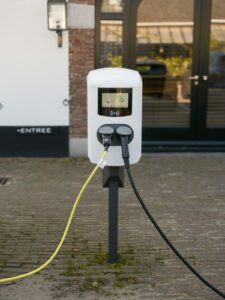
Home / EV Charging News / Autonomous driving and electric vehicles
Autonomous driving and electric vehicles are two of the most rapidly advancing technologies in the automotive industry. Together, they have the potential to revolutionize transportation, making it more efficient, safer, and more environmentally friendly. In this article, we will explore the key features of both technologies and their impact on the future of transportation.
Autonomous driving, also known as self-driving or driverless cars, is a technology that enables a vehicle to operate without human intervention. Autonomous cars use a variety of sensors and technologies, including radar, lidar, cameras, and GPS, to navigate roads, detect obstacles, and make decisions.
There are six levels of autonomous driving, defined by the Society of Automotive Engineers (SAE):
Electric vehicles (EVs) are cars powered by electricity rather than gasoline. EVs use rechargeable batteries to store energy, which powers an electric motor that drives the vehicle.
There are three types of electric vehicles:
Autonomous driving and electric vehicles offer numerous benefits, including:
Autonomous driving and electric vehicles also face several challenges, including:
The future of autonomous driving and electric vehicles is promising, with both technologies expected to become more prevalent in the coming years.
Fully autonomous vehicles are expected to become available to the general public within the next decade. The technology is expected to have a significant impact on the transportation industry, with autonomous vehicles potentially replacing traditional taxis and ride-sharing services. Autonomous trucks may also become more prevalent, which could improve the efficiency and safety of the transportation of goods.
Electric vehicles are expected to become more affordable and have longer ranges in the coming years. As battery technology improves, electric vehicles may become the dominant form of transportation, replacing traditional gasoline-powered vehicles. Governments around the world are also investing in charging infrastructure to support the growth of electric vehicles.
Autonomous driving and electric vehicles have the potential to revolutionize transportation and make it more efficient, safer, and more environmentally friendly. However, both technologies face significant challenges that must be overcome before they can be widely adopted. As the technology advances and becomes more affordable, we can expect to see more autonomous vehicles and electric vehicles on our roads in the future.
$2,890.00 Original price was: $2,890.00.$2,790.00Current price is: $2,790.00.
$3,950.00 Original price was: $3,950.00.$3,450.00Current price is: $3,450.00.
$1,650.00 Original price was: $1,650.00.$1,590.00Current price is: $1,590.00.
$2,290.00 Original price was: $2,290.00.$2,150.00Current price is: $2,150.00.
$1,290.00 Original price was: $1,290.00.$799.00Current price is: $799.00.

Your Power Management Partner for Over 25 Years Future Generations Depend on Our Decisions Today ™
2024 © All rights reserved by CyberSwitching